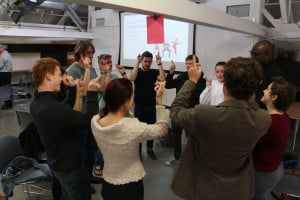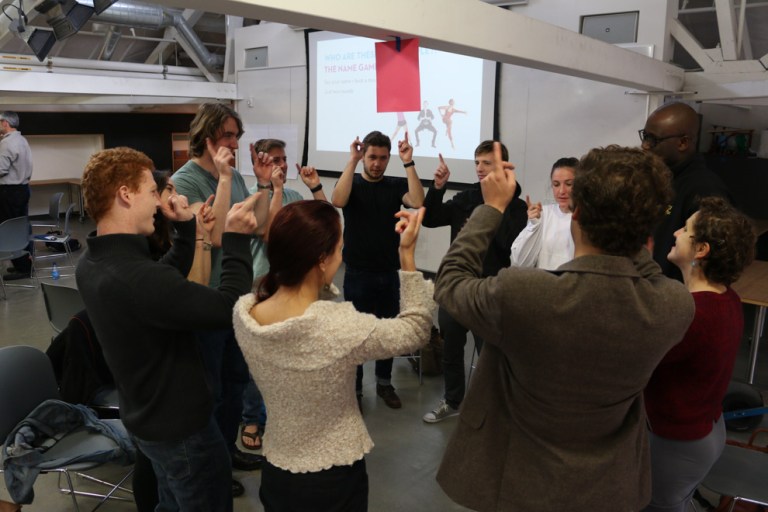
Design lecturer David Evans ’75 M.S. ’76, who leads the course ME 104B: “Designing Your Life,” sometimes gets calls from former students who, worrying that their career plans are still in flux, ask what they did wrong. Evans’ answer: nothing.
“You’re on an odyssey from the preparatory life of being a student into the life of adult autonomy,” Evans said. “The twenties aren’t about getting it right. The twenties are about trying it out.”
In short, Evans encourages his students to experiment.
“You just want to do it productively and effectively,” he said.
Enter “Designing Your Life,” which teaches juniors and seniors how to approach their post-graduation plans thoughtfully through the principles of design thinking. The course culminates in each student’s creation of an “Odyssey Plan,” a detailed imagining of three paths one’s life could take in the five years immediately after college.
Evans’ ideas for the class germinated during his own time as a Stanford undergraduate struggling to plot his future.
“I was really unhappy with the lousy help I got from my friends and parents and professors and the career center,” Evans said. “It wasn’t very good at all, and I was furious about it.”
Recalling these frustrations as well as a career-planning class he used to teach at UC Berkeley, Evans worked with associate professor of design William Burnett ’79 M.S. ’82 to create “Designing Your Life” in spring of 2012. The course was the first project of Stanford’s Life Design Lab.
Now in its seventh year, “Designing Your Life” is a popular course that, according to Evans, approximately one in seven Stanford undergraduates will take before they graduate. The Design Lab has expanded to offer “Designing Your Stanford” (for underclassmen) and “Designing the Professional” (for graduate students).
“[‘Designing Your Life’] is really well-baked now. It’s tried and true,” said Design Lecturer Gabe Wilson ’10 M.A. ’13, a member of ME 104B’s five-person teaching team.
Wilson said that life presents a complex and quickly-changing situation that design thinking refers to as a “wicked problem.” Last Friday, ME 104B instructors introduced students to elements of design thinking that they will use to attack this “wicked problem” — actions like “ideate,” “prototype” and “test.”
Students spent the bulk of class brainstorming in small groups that they will work with throughout the quarter.
They came up with solutions to mental “blocks” they had encountered and recorded over the past week: procrastination on problem sets, indecision about theses and reluctance to attend social events.
Later, in the spirit of “ideate,” students brainstormed possible combinations of post-graduation “Roles + Goals,” which ranged from “consultant paying off loans” to “wanderer exploring the world” and even to “astronaut walking the moon.”
The takeaway urged by Evans is that there are many ways to live, and students need not feel limited to one role and goal.
This idea of many ways to live underpins the Odyssey Plans that will cap off the course, in which students are asked to develop three radically different five-year plans.
“We don’t mean, in one plan go to the consulting firm McKinsey and in another plan go the consulting firm Bain,” Wilson said.
ME 104B student Kai Kane Aoki Izu ’16 knows that he is interested in nonprofit real estate, but remains uncertain about his future path and can also imagine pursuing professional dancing. He appreciated the course’s acknowledgement that life plans shift over time.
“I think one mind-blowing concept that never gets talked about at Stanford is that you will have two to three careers in your lifetime,” Aoki Izu said.
Fellow class member Cory Griffith ’17 says he is fairly confident he wants to attend graduate school for math and then go on to academia.
“But that’s a very difficult career path, and for a lot of people it just doesn’t seem to work out that well,” he said. “So if I should be looking at some alternative, I want tools to figure out what they might be.”
The very end of the course focuses on helping students decide between their options. Students will present their Odyssey Plans to their classmates, who can then give feedback about which plans they spoke about with the greatest excitement.
Wilson and Evans both emphasized that plans alone will only get one so far; the design process works through a process of test and redesign, as students act on their ideas and observe the results. Accordingly, throughout the quarter, ME 104B gives students assignments to go out, attend career fairs and network.
And even after the class ends, students can always reach out to their instructors for support as they turn plans into action, Evans said. Luckily, ME 104B offers what Evans called “office hours for life.”
Contact Hannah Knowles at hknowles ‘at’ stanford.edu.
